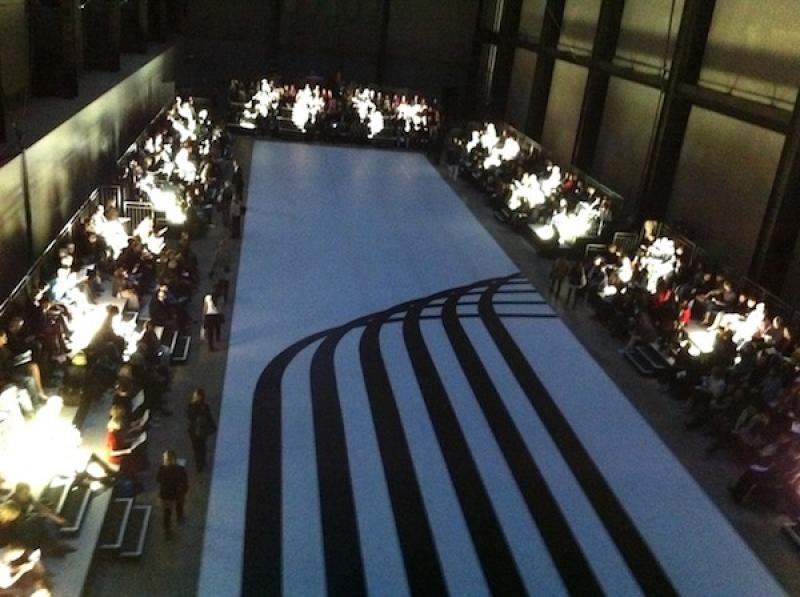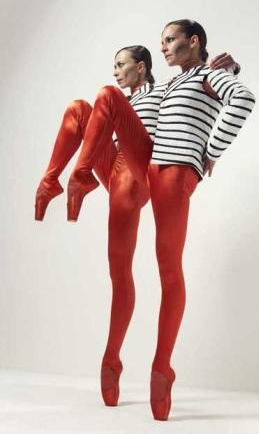Michael Clark Company, th, Tate Modern | reviews, news & interviews
Michael Clark Company, th, Tate Modern
Michael Clark Company, th, Tate Modern
Turbine Hall turned into a dance studio - it's all a bit polite

th (I'm guessing the letters stand for Turbine Hall) continues the love song to David Bowie that flowered in 2009's come, been and gone, and recycles quite a bit of that work, with the dubious new ingredient of 50 amateur volunteers brought in off the street last autumn as a community experiment. Split in two halves, created to seven Bowie songs with three more by Jarvis Cocker and Kraftwerk, th counterpoints the ordinary Joes, pinned and belted into fluffy black towels, against 13 trained dancers in sleek leotards. The towels give a puzzling air of Roman togas, while the portentous programme note states that Clark wants to invoke militarised societies and mass social actions.
My eye. I bet someone else wrote that. Anyway, there are several things wrong with this as a performance experience. First, the towels show much of the natural flobbiness of ordinary Joe legs and the volunteers know it and look generally embarrassed; second, their drills are too elementary to have much symbolic resonance; and third, they can’t even do them in sync, so there is nothing to be pondered sociologically other than why the audience screams with acclaim for their paltry efforts. (Now that's a social comment worth making, how easily audiences today think three “dance” steps is some kind of miracle.)
On the other hand, the real dancers are as sleek as seals in their second skins: their leotards change from white and black, to silver and black, to silvery orange - the last ones lighting up the dinge of the Turbine Hall something splendid. Their choreography is, as has become familiar with Clark, made up of short routines of extremely tight-arsed ballet, legs and thighs obsessively turned out, feet obsessively pointed, and with much-repeated v-e-r-y slow walking. There’s no sign yet of Clark lightening up on the hands, which remain as usual jagged as shards of glass, and the heads on the dancers’ stiff necks remain almost robotically unyielding, eyes forward, all thoughts shuttered.
I’ve been seeing this Clark signature for too long now to find it enigmatic any more - I long for a little bit of the cackle, individualism and almost holy worship of ballet’s ritual language that his great youthful pieces went in for. In the past decade that risky, psychedelic theatricality has become austerely chic, cleaned up, it’s become a script of balletic hieroglyphs, more powerful I think when read flattened on a proscenium stage, like writing on a page, than in-the-round.
Where Cunningham’s dancers would enter, flock and leave like naturally forming organisms, Clark’s seem to be placed into the stage - over here, over there, a couple in the middle. The encounters lack linking threads. The audience’s heads swing from side to side, left, right, left, right, more worried about missing something than able to fasten on a long phrase, or a sequence passing motion back and forth.
Listen to David Bowie's "Sweet Thing/Candidate"
Still, there are two or three marvellous points. In a sequence to "Sweet Thing/Candidate" (see AV above), a beautiful boy alone in the middle, spotlit in the dark, does those achingly slow, succulently thorough stretches and rolls that the boy Clark used to be glorified for, echoing the self-absorption of Jerome Robbins’s Faun - suddenly you become aware that across to the side three other men are watching this Adonis, one working at his own barre, two others upstairs on a balcony. The lad notices them, crosses to the barre, and the electric moment dissipates in work. It’s a magically erotic exploitation of the mystery of dark space between lights.

In another, the "Heroes" sequence, we see a film of David Bowie, compellingly closing in on his mischievous, seductive clown face and his vividly shifting, capriciously expressive body, while across the hall two or three dancers in black offer a steady live counterpoint. Spectator heads swivel towards the live dancers, but in the dark under the film screen as Bowie closes in foetal huddle on the ground, you could make out Clark himself in a hoodie, in an echoing sequence of Bowie/Faun-like stretches in which I thought he was looking at himself in a mirror (or iPad?). This Narcissus in the dark was a fascinating ephemera, a glimpse of a parallel world, and something so deceptive I wondered if I’d actually seen it. Is Clark's storyteller side preparing to re-emerge?
The joyfully strutting Jean Genie ballet-meets-salsa finale has been seen a couple of times before in other Clark pieces but those Stevie Stewart costumes (pictured right) remain the most exultantly saucy outfits you'll ever see on a ballet body.
- Michael Clark's th is at the Tate Modern, London, till Sunday
- Company website here
Share this article
Add comment
The future of Arts Journalism
You can stop theartsdesk.com closing!
We urgently need financing to survive. Our fundraising drive has thus far raised £49,000 but we need to reach £100,000 or we will be forced to close. Please contribute here: https://gofund.me/c3f6033d
And if you can forward this information to anyone who might assist, we’d be grateful.

Subscribe to theartsdesk.com
Thank you for continuing to read our work on theartsdesk.com. For unlimited access to every article in its entirety, including our archive of more than 15,000 pieces, we're asking for £5 per month or £40 per year. We feel it's a very good deal, and hope you do too.
To take a subscription now simply click here.
And if you're looking for that extra gift for a friend or family member, why not treat them to a theartsdesk.com gift subscription?
more Dance
 'We are bowled over!' Thank you for your messages of love and support
Much-appreciated words of commendation from readers and the cultural community
'We are bowled over!' Thank you for your messages of love and support
Much-appreciated words of commendation from readers and the cultural community
 R:Evolution, English National Ballet, Sadler's Wells review - a vibrant survey of ballet in four acts
ENB set the bar high with this mixed bill, but they meet its challenges thrillingly
R:Evolution, English National Ballet, Sadler's Wells review - a vibrant survey of ballet in four acts
ENB set the bar high with this mixed bill, but they meet its challenges thrillingly
 Like Water for Chocolate, Royal Ballet review - splendid dancing and sets, but there's too much plot
Christopher Wheeldon's version looks great but is too muddling to connect with fully
Like Water for Chocolate, Royal Ballet review - splendid dancing and sets, but there's too much plot
Christopher Wheeldon's version looks great but is too muddling to connect with fully
 iD-Reloaded, Cirque Éloize, Marlowe Theatre, Canterbury review - attitude, energy and invention
A riotous blend of urban dance music, hip hop and contemporary circus
iD-Reloaded, Cirque Éloize, Marlowe Theatre, Canterbury review - attitude, energy and invention
A riotous blend of urban dance music, hip hop and contemporary circus
 How to be a Dancer in 72,000 Easy Lessons, Teaċ Daṁsa review - a riveting account of a life in dance
Michael Keegan-Dolan's unique hybrid of physical theatre and comic monologue
How to be a Dancer in 72,000 Easy Lessons, Teaċ Daṁsa review - a riveting account of a life in dance
Michael Keegan-Dolan's unique hybrid of physical theatre and comic monologue
 A Single Man, Linbury Theatre review - an anatomy of melancholy, with breaks in the clouds
Ed Watson and Jonathan Goddard are extraordinary in Jonathan Watkins' dance theatre adaptation of Isherwood's novel
A Single Man, Linbury Theatre review - an anatomy of melancholy, with breaks in the clouds
Ed Watson and Jonathan Goddard are extraordinary in Jonathan Watkins' dance theatre adaptation of Isherwood's novel
 Peaky Blinders: The Redemption of Thomas Shelby, Rambert, Sadler's Wells review - exciting dancing, if you can see it
Six TV series reduced to 100 minutes' dance time doesn't quite compute
Peaky Blinders: The Redemption of Thomas Shelby, Rambert, Sadler's Wells review - exciting dancing, if you can see it
Six TV series reduced to 100 minutes' dance time doesn't quite compute
 Giselle, National Ballet of Japan review - return of a classic, refreshed and impeccably danced
First visit by Miyako Yoshida's company leaves you wanting more
Giselle, National Ballet of Japan review - return of a classic, refreshed and impeccably danced
First visit by Miyako Yoshida's company leaves you wanting more
 Quadrophenia, Sadler's Wells review - missed opportunity to give new stage life to a Who classic
The brilliant cast need a tighter score and a stronger narrative
Quadrophenia, Sadler's Wells review - missed opportunity to give new stage life to a Who classic
The brilliant cast need a tighter score and a stronger narrative
 The Midnight Bell, Sadler's Wells review - a first reprise for one of Matthew Bourne's most compelling shows to date
The after-hours lives of the sad and lonely are drawn with compassion, originality and skill
The Midnight Bell, Sadler's Wells review - a first reprise for one of Matthew Bourne's most compelling shows to date
The after-hours lives of the sad and lonely are drawn with compassion, originality and skill
 Ballet to Broadway: Wheeldon Works, Royal Ballet review - the impressive range and reach of Christopher Wheeldon's craft
The title says it: as dancemaker, as creative magnet, the man clearly works his socks off
Ballet to Broadway: Wheeldon Works, Royal Ballet review - the impressive range and reach of Christopher Wheeldon's craft
The title says it: as dancemaker, as creative magnet, the man clearly works his socks off
 The Forsythe Programme, English National Ballet review - brains, beauty and bravura
Once again the veteran choreographer and maverick William Forsythe raises ENB's game
The Forsythe Programme, English National Ballet review - brains, beauty and bravura
Once again the veteran choreographer and maverick William Forsythe raises ENB's game

Comments
...
...
...
...
...
...
...
...
...